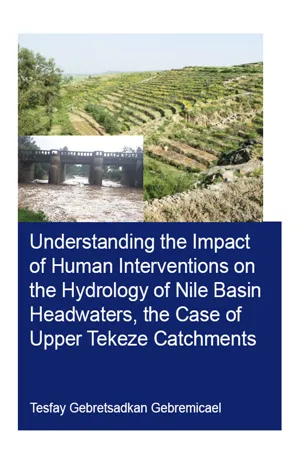
Understanding the Impact of Human Interventions on the Hydrology of Nile Basin Headwaters, the Case of Upper Tekeze Catchments
- 182 pages
- English
- ePUB (mobile friendly)
- Available on iOS & Android
Understanding the Impact of Human Interventions on the Hydrology of Nile Basin Headwaters, the Case of Upper Tekeze Catchments
About This Book
The availability and distribution of water resources in catchments are influenced by various natural and anthropogenic factors. Human-induced environmental changes are key factors controlling the hydrological flows of semi-arid catchments. Land degradation, water scarcity and inefficient utilization of available water resources continue to be important constraints for socio-economic development in the headwater catchments of the Nile river basin in particular over the Ethiopian Catchments. This research investigates the impact of landscape anthropogenic changes on the hydrological processes in the Upper Tekeze basin (A tributary of the Nile). The hydrology of the basin is investigated through analysis of hydro-climatic data, remote sensing techniques, new field measurements and parsimonious hydrological models.
The empirical evidence provided in this book confirms that human-induced environmental changes can significantly change the hydrology of catchments, both in negative (degradation) and in positive (restoration) ways. This book also shows that rainfall-runoff relationships in semi-arid catchments are non-uniform and hence the application of hydrological models in such catchments need special attention. Moreover, parsimonious dynamic hydrological model improves our understanding of the hydrological response to dynamic environmental changes.
Frequently asked questions
Information
Table of contents
- Cover
- Half Title
- Title Page
- Copyright Page
- Acknowledgements
- Summary
- Table of Contents
- List of symbols
- List of acronyms
- 1 Introduction
- 2 Study area description
- 3 Evaluation of satellite products in the Upper Tekeze basin
- 4 Temporal and spatial changes of rainfall and streamflow
- 5 Quantifying longitudinal land use/cover change in Geba catchment
- 6 Modelling hydrological response to land management dynamics
- 7 Modelling the impact of catchment management interventions on the low flows
- 8 Conclusion and recommendations
- References
- Appendix A (Chapter 3)
- Appendix B (Chapter 4)
- Appendix C (Chapter 5)
- Appendix D (Chapter 6)
- Appendix E (Chapter 7)
- SAMENVATTING
- About the author